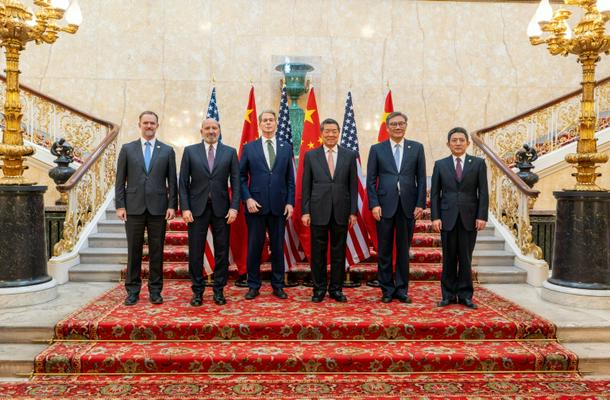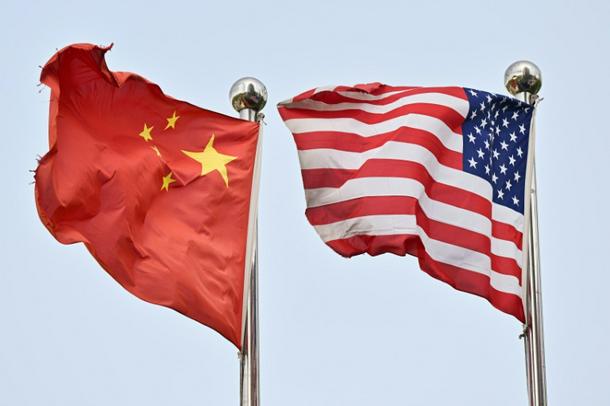
US Trade Representative Jamieson Greer, Commerce Secretary Howard Lutnick, Treasury Secretary Treasury Scott Bessent pose with Chinese Vice Premier He Lifeng, Commerce Minister Wang Wentao, and Vice Commerce Minister Li Chenggang in London
London (AFP) - A second day of high-level talks in London between the United States and China stretched into the evening Tuesday, as officials worked to defuse a bitter trade war dragging on the global economy.
Negotiators, who started meetings in the morning, held discussions throughout the day and took a break before reconvening at night, a US official told AFP.
All eyes are on the outcomes, as the world’s two biggest economies try to overcome an impasse over export curbs and come to a longer-lasting truce in their tariffs war.
US Commerce Secretary Howard Lutnick earlier told Bloomberg Television that the talks were “going well”, expecting them to last “all day”.
Global stock markets were on edge, although Wall Street’s major indexes climbed on hopes for progress.
With meetings at the UK’s historic Lancaster House dragging on, “the lack of positive headlines weighed on stocks,” said Kathleen Brooks, research director at XTB trading platform.
US President Donald Trump told reporters Monday: “We are doing well with China. China’s not easy.”
The London negotiations follow talks in Geneva last month, which saw a temporary agreement to lower tariffs.
This time, China’s exports of rare earth minerals – used in a range of things including smartphones, electric vehicle batteries and green technology – are expected to dominate the agenda.
“In Geneva, we had agreed to lower tariffs on them, and they had agreed to release the magnets and rare earths that we need throughout the economy,” Trump’s top economic adviser, Kevin Hassett, told CNBC on Monday.
Even though Beijing was releasing some supplies, “it was going a lot slower than some companies believed was optimal”, he added.
“Our expectation is that after the handshake, any export controls from the US will be eased, and the rare earths will be released in volume,” Hassett said.
- ‘Mirror arsenal’ -
Both countries “have developed almost a mirror arsenal of trade and investment weapons that they can aim at each other,” said Emily Benson, head of strategy at Minerva Technology Futures.
As they tap economic tools to try and shift global power structures, she told AFP, it may not be reasonable to expect a typical trade and investment deal from talks.

There were hopes that the talks will ease tensions between the economic superpowers
But both sides could find ways to level off a downward spiral.
Tensions between Washington and Beijing have heightened since Trump took office in January, with the countries engaging in a tariffs war.
The Geneva pact temporarily brought new US tariffs on Chinese goods down from 145 percent to 30 percent, and Chinese countermeasures from 125 percent to 10 percent.
But Trump later said China had “totally violated” the deal.
A dialing-down of temperatures could involve Chinese efforts to shore up some export control licenses caught in their system, Benson said. She noted Beijing appeared understaffed given the volume of requests.
On the US side, this could look like a relaxation of certain export curbs in the high-tech domain, she added.
But observers remain cautious.
“We doubt that the US will back off completely. That’s likely to restrain any relief rally,” said Thomas Mathews, head analyst of Asia Pacific markets for Capital Economics.
Since returning to office, Trump has slapped a 10 percent levy on friend and foe, threatening steeper rates on dozens of economies.
His tariffs have dented trade, with Beijing data showing Chinese exports to the United States plunged in May.
The World Bank on Tuesday joined other international organizations to slash its 2025 global growth forecast amid trade uncertainty.
Meanwhile, China is in talks with partners including Japan and South Korea to try to build a united front countering Trump’s tariffs.
Chinese leader Xi Jinping on Tuesday urged South Korea’s new President Lee Jae-myung to work with Beijing to uphold free trade and ensure “the stability and smooth functioning of global and regional industrial and supply chains,” Xinhua news agency said.
Chinese Vice Premier He Lifeng is heading the team in London, which includes Commerce Minister Wang Wentao and China International Trade Representative Li Chenggang.
US Treasury Secretary Scott Bessent, Lutnick and Trade Representative Jamieson Greer are leading the American delegation.